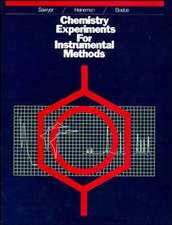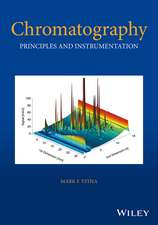High Performance Liquid Chromatography: Chemical Laboratory Practice
Autor Heinz Engelhardt Traducere de G. Gutnikoven Limba Engleză Paperback – 19 ian 2012
Preț: 388.72 lei
Nou
Puncte Express: 583
Preț estimativ în valută:
74.38€ • 77.82$ • 61.79£
74.38€ • 77.82$ • 61.79£
Carte tipărită la comandă
Livrare economică 02-16 aprilie
Preluare comenzi: 021 569.72.76
Specificații
ISBN-13: 9783642670664
ISBN-10: 3642670660
Pagini: 268
Ilustrații: XII, 254 p.
Dimensiuni: 170 x 244 x 14 mm
Greutate: 0.43 kg
Ediția:Softcover reprint of the original 1st ed. 1979
Editura: Springer Berlin, Heidelberg
Colecția Springer
Seria Chemical Laboratory Practice
Locul publicării:Berlin, Heidelberg, Germany
ISBN-10: 3642670660
Pagini: 268
Ilustrații: XII, 254 p.
Dimensiuni: 170 x 244 x 14 mm
Greutate: 0.43 kg
Ediția:Softcover reprint of the original 1st ed. 1979
Editura: Springer Berlin, Heidelberg
Colecția Springer
Seria Chemical Laboratory Practice
Locul publicării:Berlin, Heidelberg, Germany
Public țintă
ResearchCuprins
I. Chromatographic Processes.- References Chapter I.- II. Fundamentals of Chromatography.- A. Retention.- B. Linear Flow Rate, Porosity, Permeability.- C. Band Broadening.- D. Resolution.- E. Dependence of Band Broadening on Flow Rate.- F. Band Broadening and Particle Size.- G. Extra-Column Band Broadening.- H. Optimum Analysis Conditions and Analysis Time.- I. Selection of a Suitable Column.- References Chapter II.- III. Equipment for HPLC.- A. Solvent Reservoir — Degassing of the Eluent.- B. Pumps.- C. Damping of the Pulsations.- D. Sample Introduction.- E. The Column.- F. Thermostating.- G. Measurement of the Flow Rate.- H. Fraction Collectors.- I. Recorders.- J. Instrumentation for Gradient Elution.- K. Safety Measures.- References Chapter III.- IV. Detectors.- A. UV Detectors.- B. Differential Refractometer.- C. Microadsorption Detector.- D. Transport Detector (Flame Ionization Detector).- E. Fluorescence Detector.- F. Other Detectors.- G. Comparison of the Important Detectors.- H. Reaction Detectors.- References Chapter IV.- V. Stationary Phases.- A. Packing Materials for Adsorption and Partition Chromatography.- B. Chemically Modified Supports.- C. Ion Exchangers.- D. Stationary Phases for Exclusion Chromatography.- References Chapter V.- VI. Adsorption Chromatography.- I. Polar Stationary Phases.- II. Nonpolar Stationary Phases.- III. The General Elution Problem.- IV. Applications of Adsorption Chromatography.- References Chapter VI.- VII. Partition Chromatography.- A. Introduction.- B. Supports and Liquid Phases.- C. Properties of the Column.- D. Applications.- E. Ion-pair Chromatography.- References Chapter VII.- VIII. Ion-Exchange Chromatography.- A. Principle.- B. Ion Exchange Materials.- C. Characterization of the Ion Exchangers.- D. Optimizing aSeparation.- E. Applications.- References Chapter VIII.- IX. Exclusion Chromatography. Gel Permeation Chromatography.- A. Introduction.- B. Basics of Exclusion Chromatography.- C. Stationary Phases for Exclusion Chromatography.- D. Applications of Exclusion Chromatography.- References Chapter IX.- X. Selection of the Separation System.- References Chapter X.- XI. Special Techniques.- A. Preparative Chromatography.- B. Qualitative Analysis.- C. Quantitative Analysis.- D. Trace Analysis.- References Chapter XI.- XII. Purification of Solvents.- References Chapter XII.











